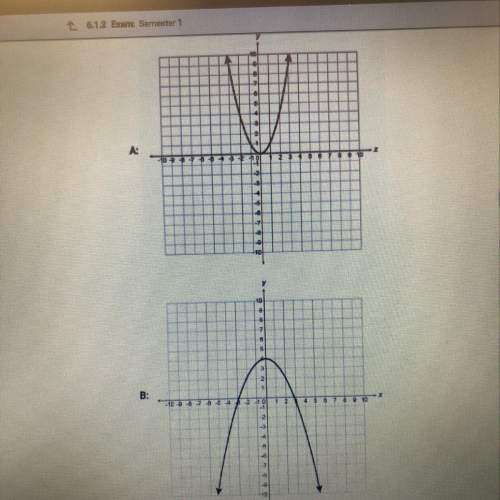
Mathematics, 24.09.2019 08:30 shay7298
Iwant to build a right triangular deck behind my house. the hypotenuse of the deck will be 40 feet long. the other two sides of the deck will be equal in length. what is the length of the deck?

Answers: 1


Other questions on the subject: Mathematics

Mathematics, 21.06.2019 16:30, dimpleschris101
Marco is studying a type of mold that grows at a fast rate. he created the function f(x) = 345(1.30)x to model the number of mold spores per week. what does the 1.30 represent? how many mold spores are there after 4 weeks? round your answer to the nearest whole number. 1.30 represents the number of mold spores marco had at the beginning of the study; 985 mold spores 1.30 represents the number of mold spores grown in a given week; 448 mold spores 1.30 represents the 30% rate of weekly growth; 345 mold spores 1.30 represents the 30% rate of weekly growth; 985 mold spores
Answers: 1

Mathematics, 21.06.2019 17:30, fonsworth5
Kathy spent 5/8 of her money on books and another 1/6 of her money on stationeries. what fraction of kathy’s money was left?
Answers: 2

Mathematics, 21.06.2019 19:30, MagicDragon4734
Which of the points a(6, 2), b(0, 0), c(3, 2), d(−12, 8), e(−12, −8) belong to the graph of direct variation y= 2/3 x?
Answers: 2

Mathematics, 21.06.2019 21:30, gonzalezashley152
In a test for esp (extrasensory perception), the experimenter looks at cards that are hidden from the subject. each card contains either a star, a circle, a wave, a cross or a square.(five shapes) as the experimenter looks at each of 20 cards in turn, the subject names the shape on the card. when the esp study described above discovers a subject whose performance appears to be better than guessing, the study continues at greater length. the experimenter looks at many cards bearing one of five shapes (star, square, circle, wave, and cross) in an order determined by random numbers. the subject cannot see the experimenter as he looks at each card in turn, in order to avoid any possible nonverbal clues. the answers of a subject who does not have esp should be independent observations, each with probability 1/5 of success. we record 1000 attempts. which of the following assumptions must be met in order to solve this problem? it's reasonable to assume normality 0.8(1000), 0.2(1000)%30 approximately normal 0.8(1000), 0.2(1000)% 10 approximately normal srs it is reasonable to assume the total number of cards is over 10,000 it is reasonable to assume the total number of cards is over 1000
Answers: 1
You know the right answer?
Iwant to build a right triangular deck behind my house. the hypotenuse of the deck will be 40 feet l...
Questions in other subjects:



Mathematics, 23.06.2019 14:40



English, 23.06.2019 14:40


Business, 23.06.2019 14:40

History, 23.06.2019 14:40

Mathematics, 23.06.2019 14:40




